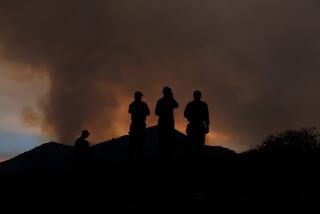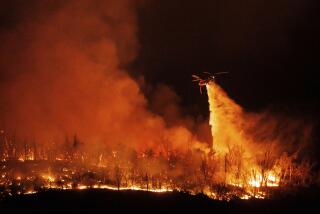As flames tear through wine country, residents flash back to 2017
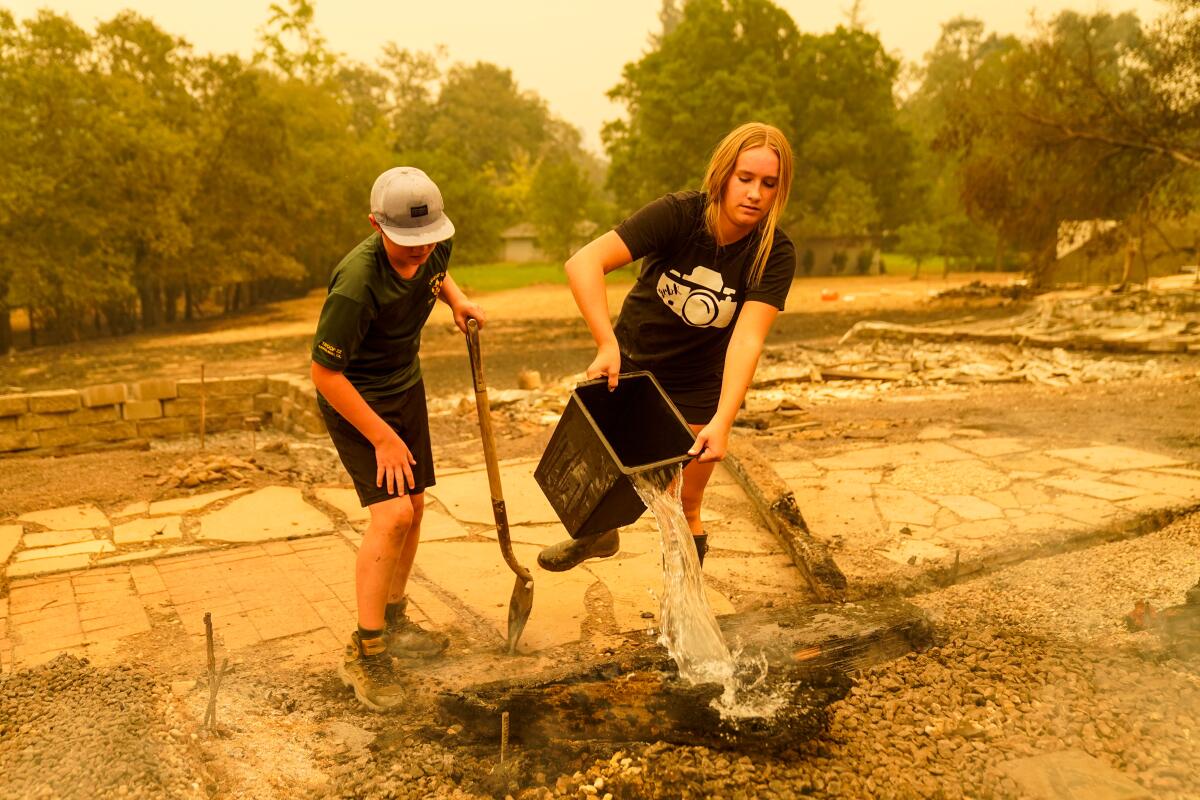
- Share via
SANTA ROSA — In the hills above Highway 12, Emmilia Carrington hoisted a trash can full of water into her neighbor’s backyard and tipped it over, turning smoldering ash into a rush of steam that curled up over her black rain boots.
Nearby, the 15-year-old’s brother Brody, three years younger, picked up a shovel and dumped dust over live embers, as he’d learned to do in Boy Scouts. Their mother, Eliza, smothered flames with garden stones.
The family evacuated late Sunday, as flames from the fast-spreading Glass fire licked over a ridge, but had returned Monday morning after Eliza sweet-talked her way past law enforcement.
“Oh my God!” she said Monday afternoon, surveying the hot spots surrounding her home.
It felt like terrible déjà vu.
While ash snowed down across the Sonoma County town of Santa Rosa, the fire — which by Monday evening had burned more than 36,000 acres, prompting tens of thousands of evacuations — was dredging up memories of the deadly Tubbs and Nuns fires that devastated wine country in 2017.
Towering oak trees lining Highway 12 burned from the inside out, oozing orange lava, and a herd of bewildered deer pranced between trees, trying to avoid the flames. Overnight, residents at Oakmont Village, a senior-living community, filed slowly out the front door and loaded onto city buses, which evacuated them beneath a salmon sky.
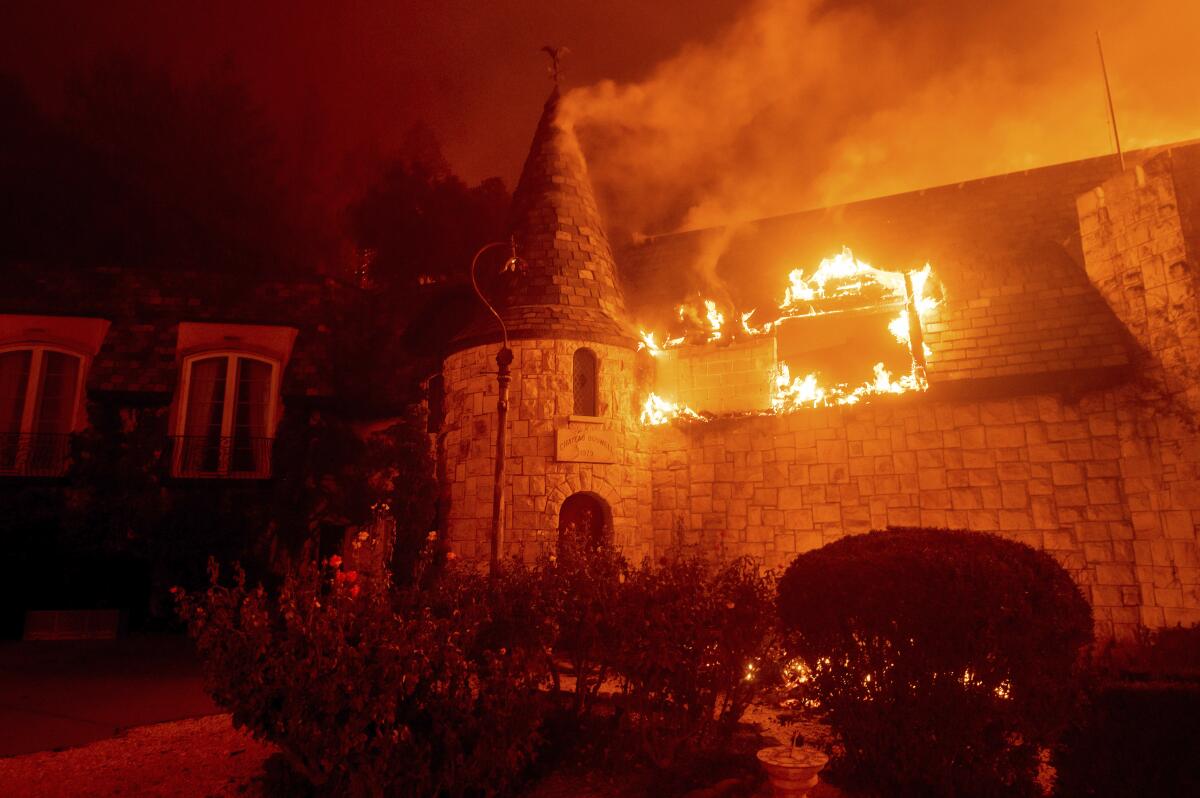
Along a beloved stretch of vineyards and tasting rooms, the Glass Mountain Inn charred overnight, as did the distinctive stone structure at the famed Chateau Boswell Winery, where flames singed the skins of plump bunches of grapes. At least eight wineries were damaged, officials said, noting that the fate of a handful of others was still unknown Monday evening.
Some were hesitant to flee. Monday morning, Ben Illia stood in the front yard of the gray ranch house where he had grown up watering down the landscape with a hose. Nearby, a sprinkler sprayed an arc over the grass.
Behind him, the hills of Trione-Annadel State Park smoldered, disturbing columns of black smoke rising here and there as embers sparked new burns. But Illia was unconcerned. A veteran of the Tubbs fire, he had no plans to leave unless “I see flames coming over the hill,” he said.
Others were more cautious. Rincon Valley resident Randi Cornwall said her family was lucky to live in a small pocket of Santa Rosa that survived the 2017 Tubbs fire, the 2019 Kincade fire and the wildfires last month. But, she said, fear and bad memories remain.
“The Tubbs trauma is real,” Cornwall said. “When you have seen fire move fast before, you know to get the hell out before traffic backs up and fire is licking at your cars.”
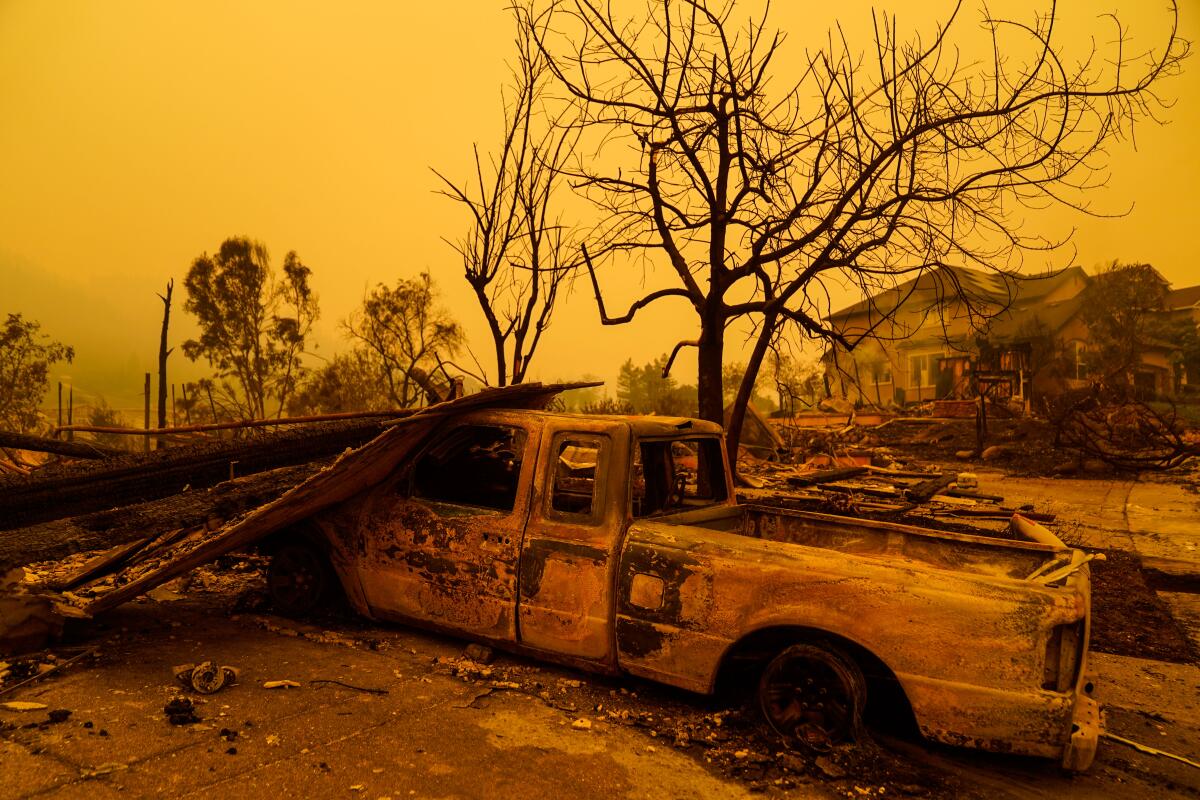
During the Tubbs fire, officials delayed warnings out of fear that a mass evacuation would cause panic and clog narrow roads that firefighters needed to access. Evacuation orders only went to a fraction of residents, leaving entire communities in the dark about their danger. Ultimately, 22 people died.
This time, public warnings and orders to leave began within half an hour of the realization that embers had kicked off a new blaze headed toward Santa Rosa. And although the main road on the fireside of town became gridlocked midway through the night, traffic had started flowing again within two hours.
“This isn’t our first rodeo,” Santa Rosa Mayor Tom Schwedhelm said during a news conference, crediting seasoned residents and emergency planners for an unpanicked evacuation.
Even still, officials said, sheriff’s deputies had to rescue some residents who hadn’t evacuated Sunday night, as howling Diablo winds sent flames leaping across Highway 12. Some of the people who were rescued had injuries, officials said, but they declined to offer more details.
California’s fire season struck hard and early this year, in part because August was the hottest on record statewide.
A freakish lightning storm last month also sparked numerous blazes, although not the Glass fire threatening Santa Rosa and surrounding communities. That fire started Sunday morning near St. Helena. The cause is yet unknown.
On Monday morning on a cul-de-sac not far from the Sonoma County Fairgrounds, which often serves as an evacuation center, Mat Tamba stood in front of his home. This time, however, the flames were too close to shelter at the fairground.
Tamba, who had evacuated the night before but returned for toiletries and a Minnie Mouse stuffed animal for his daughter, watched as a plume floated over the ridge. He flashed back to the Tubbs fire, which burned his in-laws’ home to the ground and thought about the dreaded popping sound he’d heard again last night and instantly recognized as propane tanks exploding in the distance.
“That’s when it becomes eerie,” he said.
All along the sidewalk, neighbors had pulled propane tanks from their barbecue grills and moved them to the street — a lesson learned from the Tubbs fire.
Around the corner, Marilyn Heller blew away a thick coat of ash blanketing the hood of her Porsche Cayenne. The 72-year-old was packing up a few last things from inside her beloved ranch-style home, which she’s lived in since 1974, when she and her husband purchased it for $39,000.
Trained in the dangers in these hills, she had already packed up everything of sentimental value, including hand-me-downs from her grandmother and aunt, and had filled 40 boxes. After previous fires, Heller said, her son, a former Marine, had bought her a device that she described as a special, heat-resistant straw, which she could use to breathe underwater if she needed to hop into the pool to survive.
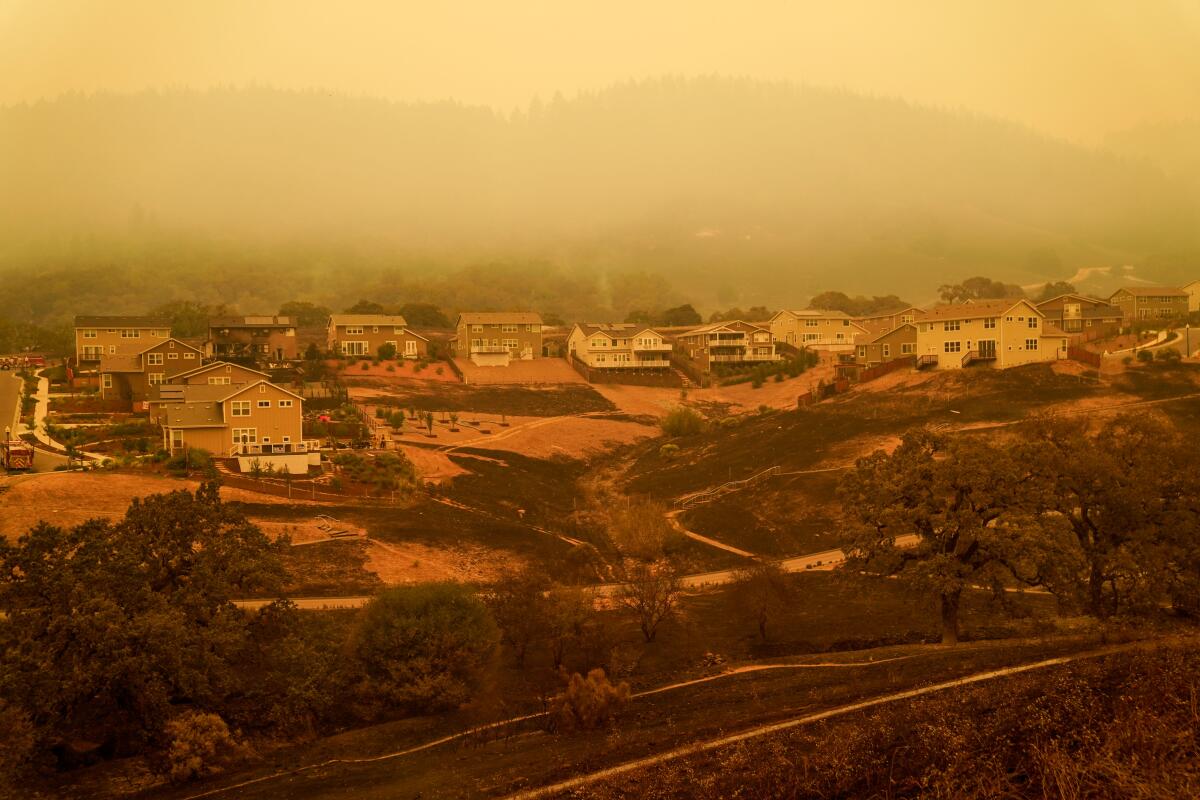
For anyone surveying the surrounding hills, the capriciousness of the falling embers was all too evident. They spared many of the million-dollar houses in a neighborhood known as Skyview, but charred a stretch of homes nearby. Midday Monday, firefighters were trying to put out a stubborn blaze at a green-stucco home, already destroyed by flames, and later in the day, as the fire marched on, the entire city of Calistoga was ordered to evacuate.
With many weeks of potentially dangerous fire conditions still ahead — the Tubbs fire started in early October and burned through the entire month — 2020 has already shattered records as a historically devastating fire season in the state. So far this year, flames from 8,100 wildfires, 35 of which are currently burning, have charred through more than 3.7 million acres across the state, killing 29 people and burning some 7,000 structures.
In Butte County, the still-burning North Complex fire, which has killed 15 people, destroyed much of the town of Berry Creek and burned 306,000 acres, prompted evacuation warnings on Monday in the town of Paradise, which was destroyed in the Camp fire in 2018.
In Shasta County, the newly ignited Zogg fire claimed more California lives on Monday, killing three people and prompting massive evacuations as it tore through hundreds of acres in less than an hour. By Monday night, that had brought this statewide death toll for this fire season to 29 people.
Late in the day, the Zogg fire had grown to 15,000 acres. In the foothills above Santa Clarita, a quick-moving brush fire started Monday afternoon, burning 200 acres within minutes.
Back in Santa Rosa on Monday afternoon, Jeff Sengstack stood outside his home on a hill just outside the evacuation advisory zone.
For now, the fire was still four miles away.
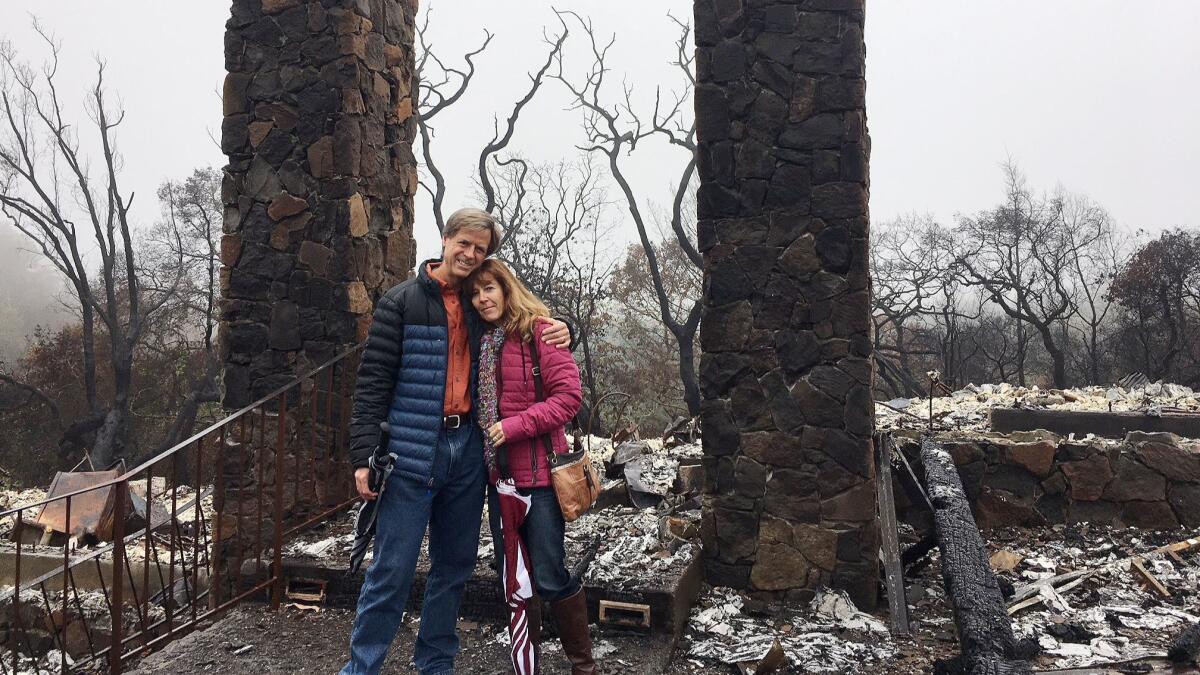
But he knew how devastatingly fast flames could travel here. Three years ago, Sengstack and his wife, Birgit, fled their home in the middle of the night as ruby embers rained down. Two minutes after they pulled out of the driveway, the home they had lived in for 18 years was engulfed in flames.
It took them three years to rebuild and they finally returned home in July. So on Sunday, as Sengstack watched from his porch as flames shot hundreds of feet into the night sky, he felt deeply stressed. His head pulsed.
“Chest-tightening,” said Sengstack, 71, who choked back tears.
The wind had thundered around 1 a.m. Monday, but eventually calmed and Sengstack managed to get a bit of sleep. If they ultimately need to evacuate, they’ll head to a friend’s home in Belvedere. They won’t take much with them, he said, as they lost almost everything of value in the fire three years ago.
Sengstack hoped that the winds would stay calm and he and his wife could stay put in their new home — his simple modern farmhouse, he calls it.
More to Read
Sign up for Essential California
The most important California stories and recommendations in your inbox every morning.
You may occasionally receive promotional content from the Los Angeles Times.

